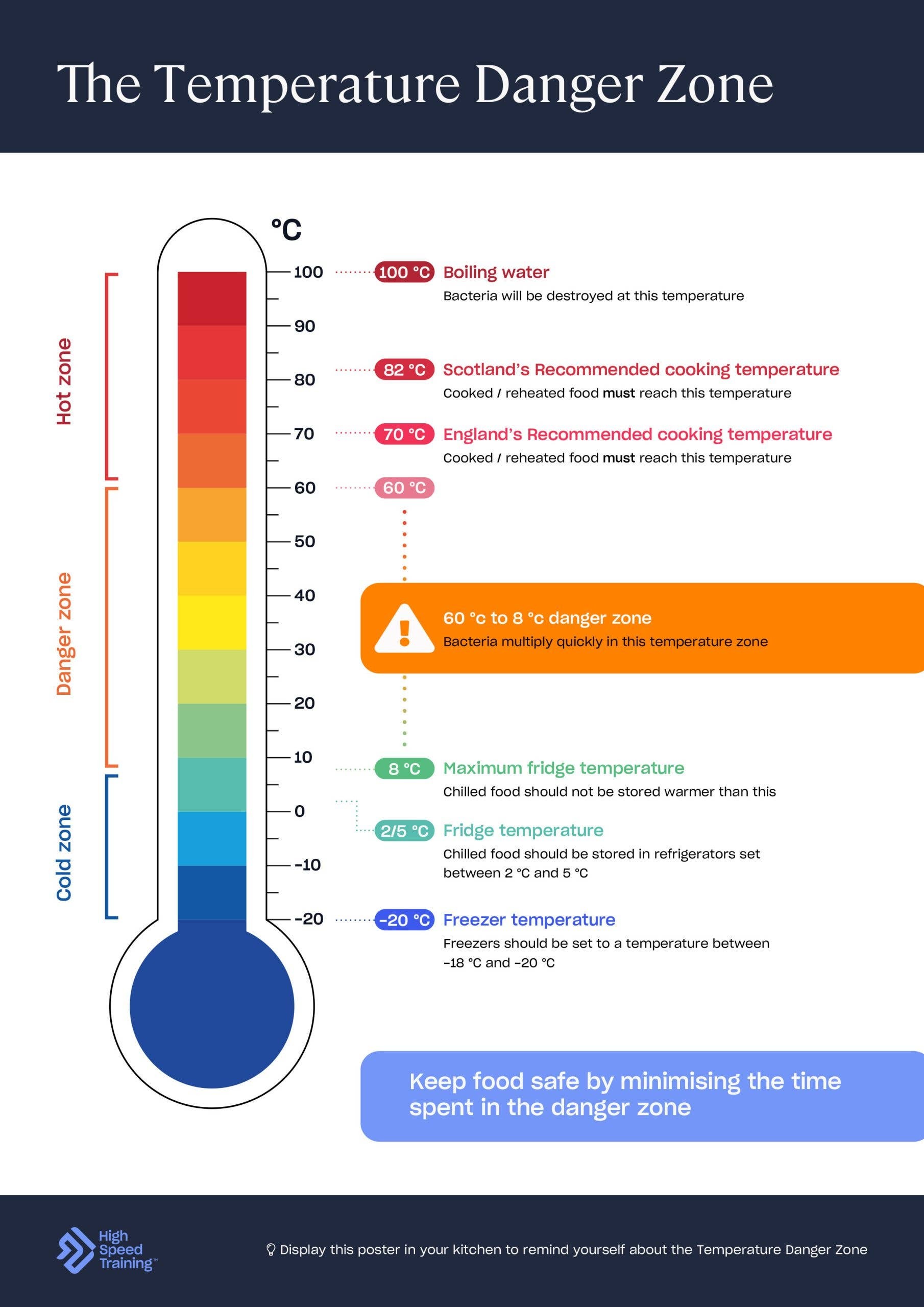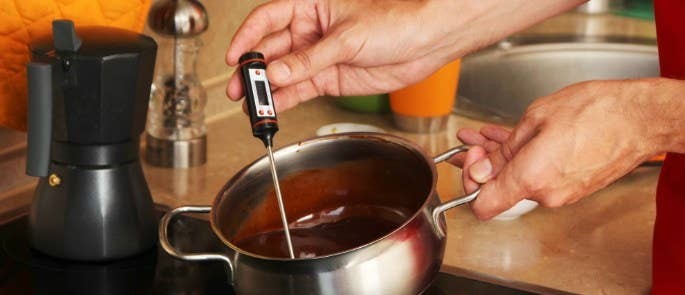What Is The Temperature Danger Zone? It’s a critical question for anyone handling food, and WHAT.EDU.VN is here to provide a clear, concise answer. Understanding this zone, and how to avoid it, is crucial for preventing foodborne illnesses. This guide covers everything you need to know about safe food temperatures, bacterial growth, and food safety practices, ensuring you prepare and store food safely. Let’s explore the critical temperatures, contamination prevention and hygiene standards.
1. Understanding The Temperature Danger Zone: An Overview
The temperature danger zone is the temperature range where harmful bacteria can grow rapidly in food, increasing the risk of foodborne illness. Knowing and avoiding this zone is fundamental to food safety.
- Definition: The temperature range in which bacteria multiply most rapidly, making food unsafe to eat.
- Importance: Staying outside this zone through proper heating, cooling, and storage practices prevents foodborne illnesses.
The Food Standards Agency (FSA) defines this danger zone as between 8°C (46°F) and 60°C (140°F). To ensure food safety, keep it either colder or hotter than this range. For an added layer of safety, heating food above 70°C (158°F) is recommended.
2. Why is the Temperature Danger Zone Important?
The temperature danger zone is crucial because it directly impacts the growth of bacteria in food. Bacteria thrive in certain temperature conditions, and their rapid multiplication can lead to food spoilage and foodborne illnesses.
Bacterial Growth
Bacteria are microscopic organisms that can be found everywhere, including in food. While some bacteria are harmless, others can cause illness when consumed in large quantities. The rate at which bacteria grow depends on several factors, including:
- Temperature: Bacteria grow most rapidly in the temperature danger zone.
- Moisture: Bacteria need moisture to grow, so foods with high moisture content are more susceptible to bacterial growth.
- Nutrients: Bacteria need nutrients to grow, so foods rich in protein and carbohydrates are more susceptible to bacterial growth.
- pH level: Bacteria grow best in neutral or slightly acidic environments.
- Time: The longer food is left in the temperature danger zone, the more bacteria will grow.
Food Spoilage
When bacteria grow in food, they produce enzymes that break down the food’s components. This can cause the food to spoil, resulting in changes in taste, texture, and appearance. Spoiled food is not only unappetizing but can also be unsafe to eat.
Foodborne Illnesses
Foodborne illnesses, also known as food poisoning, are caused by consuming food contaminated with harmful bacteria, viruses, or parasites. Symptoms of foodborne illnesses can range from mild to severe and may include nausea, vomiting, diarrhea, abdominal cramps, and fever. In some cases, foodborne illnesses can be life-threatening, especially for vulnerable populations such as young children, pregnant women, older adults, and individuals with weakened immune systems.
Understanding the temperature danger zone and following proper food safety practices can help prevent bacterial growth, food spoilage, and foodborne illnesses.
3. Detailed Temperature Guidelines For Food Safety
Maintaining correct temperatures is key to food safety. Different temperatures either slow down or eliminate bacterial growth.
- Chilling: Temperatures below 8°C (46°F) significantly slow bacterial growth. Ideally, keep chilled foods below 5°C (41°F).
- Freezing: While freezing slows growth, it doesn’t eliminate bacteria. Handle defrosted food with care and cook thoroughly.
- Heating: Heating food above 60°C (140°F) slows bacterial growth, but 70°C (158°F) or higher is recommended to kill bacteria effectively.
4. Understanding the Danger Zone’s Range
To reiterate, the danger zone lies between 8°C (46°F) and 60°C (140°F). It’s crucial to quickly move food through this range to minimize bacterial growth.
| Temperature | Effect on Bacteria | Food Safety Implication |
|---|---|---|
| Below 8°C (46°F) | Slows bacterial growth | Safe for chilling and storing food to inhibit bacterial multiplication. |
| 8°C (46°F) to 60°C (140°F) | Rapid bacterial growth | The “danger zone” where bacteria multiply quickly, increasing the risk of food spoilage and foodborne illnesses. |
| Above 60°C (140°F) | Bacteria growth slows, start to die | Cooking or heating food to these temperatures helps kill harmful bacteria and make the food safe to eat. |
| 70°C (158°F) and higher | Bacteria are killed effectively | Ensures food is safe to eat by eliminating most harmful bacteria. Recommended for thorough cooking and heating. |


5. Practical Steps to Keep Food Safe
Keeping food out of the temperature danger zone involves several key practices:
5.1. Safe Defrosting
Defrost food in the refrigerator, in cold water (changing the water every 30 minutes), or in the microwave. Never defrost food at room temperature.
5.2. Proper Cooking
Use a food thermometer to ensure that food is cooked to a safe internal temperature. Refer to recommended cooking temperatures for different types of food.
5.3. Rapid Cooling
Cool cooked food quickly by dividing it into smaller portions and refrigerating it promptly. Don’t leave food at room temperature for more than two hours.
5.4. Safe Storage
Store food at the correct temperature in the refrigerator or freezer. Use airtight containers to prevent contamination and maintain quality.
| Food Type | Recommended Internal Temperature |
|---|---|
| Poultry | 74°C (165°F) |
| Ground Meat | 71°C (160°F) |
| Pork | 63°C (145°F) |
| Fish | 63°C (145°F) |
6. Cooking Times and Temperatures: Striking the Right Balance
The time food spends at a particular temperature is just as crucial as the temperature itself.
- 70°C (158°F): Food must stay at this temperature for at least 2 minutes to kill bacteria.
- 80°C (176°F): At this temperature, food only needs to maintain the heat for 6 seconds.
7. Monitoring Food Temperature: Essential Tools and Techniques
Using thermometers is crucial for checking food temperatures.
7.1. Probe Thermometers
Insert the probe into the thickest part of the food, avoiding bones or the pan’s bottom.
7.2. Infrared Thermometers
These are useful for quickly checking the surface temperature of food deliveries or stored items.
7.3. Monitoring Storage Units
Ensure that refrigerators and freezers have built-in or added thermometers to monitor the temperature regularly.
8. The Importance of Hygiene: More Than Just Temperature
While temperature control is critical, maintaining good hygiene practices in the kitchen is equally important.
8.1. Handwashing
Wash hands thoroughly with soap and water before and after handling food.
8.2. Preventing Cross-Contamination
Use separate cutting boards and utensils for raw and cooked foods. Clean and sanitize surfaces and equipment regularly.
9. Food Safety Regulations and Standards
Adhering to food safety regulations and standards is essential for ensuring the safety of the food supply. These regulations and standards are designed to protect consumers from foodborne illnesses and other food-related hazards.
9.1. Hazard Analysis and Critical Control Points (HACCP)
HACCP is a systematic approach to identifying, evaluating, and controlling food safety hazards. It involves conducting a hazard analysis, identifying critical control points (CCPs), establishing critical limits, monitoring CCPs, taking corrective actions, verifying the system, and maintaining records.
9.2. Good Manufacturing Practices (GMPs)
GMPs are a set of guidelines that outline the minimum requirements for manufacturing food products in a safe and sanitary manner. They cover various aspects of food production, including facility design, equipment maintenance, sanitation, pest control, and employee hygiene.
9.3. Food Safety Audits
Food safety audits are conducted to assess the compliance of food businesses with food safety regulations and standards. Audits may be conducted by regulatory agencies, third-party certification bodies, or internal auditors.
9.4. Food Safety Training
Food safety training is essential for ensuring that food handlers have the knowledge and skills necessary to handle food safely. Training programs cover topics such as foodborne illnesses, personal hygiene, cross-contamination prevention, and safe food handling practices.
10. Addressing Common Myths and Misconceptions
Many misconceptions surround food safety, which can lead to unsafe practices.
- Myth: Freezing food kills bacteria.
- Fact: Freezing only slows bacterial growth; it doesn’t eliminate bacteria.
- Myth: If food looks and smells okay, it’s safe to eat.
- Fact: Harmful bacteria can grow in food without altering its appearance, smell, or taste.
- Myth: Marinating meat at room temperature is safe.
- Fact: Marinating meat at room temperature can allow bacteria to grow rapidly. Always marinate meat in the refrigerator.
11. Q&A: Frequently Asked Questions About the Temperature Danger Zone
| Question | Answer |
|---|---|
| What is the temperature danger zone? | The temperature range between 8°C (46°F) and 60°C (140°F) where bacteria multiply most rapidly. |
| How can I keep food out of the temperature danger zone? | By chilling food properly, cooking it to safe internal temperatures, and cooling it quickly after cooking. |
| Does freezing food kill bacteria? | No, freezing only slows bacterial growth. Handle defrosted food with care. |
| How long can food safely stay in the temperature danger zone? | No more than two hours. If the temperature is above 90°F (32°C), limit the time to one hour. |
| What temperature should my refrigerator be? | Between 1°C (34°F) and 5°C (41°F). |
| How do I use a food thermometer correctly? | Insert the thermometer into the thickest part of the food, away from bones. |
| Is it safe to taste food to see if it has spoiled? | No, tasting food to check for spoilage can be dangerous. If you suspect food has spoiled, discard it. |
| How often should I clean my refrigerator? | Clean your refrigerator regularly, at least once a month, to prevent bacterial growth. |
| What are the symptoms of foodborne illness? | Nausea, vomiting, diarrhea, abdominal cramps, and fever. Seek medical attention if symptoms are severe. |
| Where can I get more information about food safety? | Consult resources like WHAT.EDU.VN, the Food Standards Agency (FSA), or your local health department. |
12. The Future of Food Safety: Innovations and Trends
The field of food safety is constantly evolving, with new innovations and trends emerging to improve food safety practices and reduce the risk of foodborne illnesses.
12.1. Advanced Technologies
Advanced technologies such as blockchain, artificial intelligence (AI), and the Internet of Things (IoT) are being used to enhance food traceability, monitor food safety conditions, and detect potential hazards in real-time.
12.2. Sustainable Practices
There is a growing emphasis on sustainable food safety practices that minimize environmental impact and promote responsible food production. This includes reducing food waste, using eco-friendly packaging, and implementing energy-efficient technologies.
12.3. Consumer Education
Empowering consumers with knowledge and resources to make informed food safety decisions is crucial. This includes providing clear and accurate information about food safety risks, safe food handling practices, and proper food storage techniques.
13. Conclusion: Prioritizing Food Safety
Understanding and controlling the temperature danger zone is essential for preventing foodborne illnesses. By adhering to the guidelines and practices outlined in this guide, you can ensure that the food you prepare and serve is safe to eat.
Remember, food safety is a shared responsibility. Whether you are a home cook, a professional chef, or a food business owner, everyone has a role to play in ensuring the safety of the food supply. By prioritizing food safety, we can protect our health, prevent foodborne illnesses, and promote a healthier and safer world for all.
Still have questions about food safety or anything else? Visit WHAT.EDU.VN today and ask your question for free! Our community of experts is ready to provide you with the answers you need. Don’t hesitate – your peace of mind is just a question away.
Contact us at:
Address: 888 Question City Plaza, Seattle, WA 98101, United States
Whatsapp: +1 (206) 555-7890
Website: what.edu.vn
